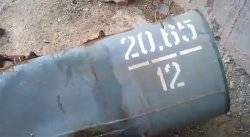Syrian regime forces have dropped Russian-made cluster bombs over civilian areas in the past week as they battle to reverse opposition gains on a strategic highway, according to the watchdog group Human Rights Watch.
The bombs were dropped from planes and helicopters, with many of the strikes taking place near the main north-south highway running through the northwestern town of Maarat al-Numan, HRW said in a report released on Sunday.
Opposition forces seized Maarat al-Numan from President Bashar al-Assad's troops last week, cutting the route from the capital Damascus to Aleppo, Syria's biggest city. Regime forces have been trying to retake the area since then.
HRW previously reported Syrian use of cluster bombs, which have been banned by most countries, in July and August but the renewed strikes indicate the government's determination to regain strategic control in the northwest.
Cluster munitions can drop hundreds of bomblets on a wide area as an anti-personnel weapon, designed to kill as many people as possible. Human rights groups say their use in civilian-populated areas can be a war crime.
More than 100 nations have banned their use, stockpiling, transfer or sale under a convention which became international law in 2010, but Syria has not signed it, nor have Russia, China or the US.
Long-term damage
Bomblets that do not initially explode can litter the ground, killing and maiming civilians long after a war is over. Towns targeted included Maarat, Tamanea, Taftanaz and al-Tah.
Cluster bombs have also been used in other areas in Homs, Aleppo and Lattakia provinces as well as near Damascus, the New York-based rights group said.
"Syria's disregard for its civilian population is all too evident in its air campaign, which now apparently includes dropping these deadly cluster bombs into populated areas," Steve Goose, arms director at HRW, said.
Syrian government officials were not immediately available to comment on the HRW report.
Initial information about the use of the explosives came from videos posted online by opposition activists although HRW investigators said it had confirmed the incidents in interviews with resident in two towns.
It had no information on casualties. The cluster bombs were Russian-made but it was not known how or when Syria acquired them, HRW said.
Residents from Taftanaz and Tamanea - both near Maarat al-Numan - told HRW interviewers that helicopters dropped cluster munitions on or near their towns last Tuesday.
One that hit Tamanea released smaller bomblets in an area between two schools, a resident was quoted as saying in the HRW report.
"The bomblets that exploded were the ones that hit the ground on the tip, we collected the ones that didn't explode, their tip didn't touch the ground," the resident said.
People were taking away unexploded bomblets as souvenirs, a highly dangerous action as they can still explode at the slightest touch or movement. Video showed some civilians carrying the bomblets around and throwing them on the ground.
"The cluster munition strikes and unexploded ordnance they leave behind pose a huge danger to civilian populations, who often seem unaware how easily these submunitions could still explode," Goose said.
PHOTO CAPTION
This citizen journalism image taken from video provided by Ugarit News, which has been authenticated based on its contents and other AP reporting, shows what Human Rights Watch says are cluster bombs dropped in Tamanea, Syria on Oct. 9, 2012.
Source: Aljazeera.com


 Home
Home Discover Islam
Discover Islam Quran Recitations
Quran Recitations Lectures
Lectures
 Fatwa
Fatwa Articles
Articles Fiqh
Fiqh E-Books
E-Books Boys & Girls
Boys & Girls  Articles
Articles










